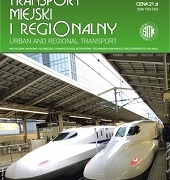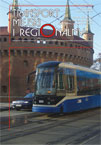Abstract 11/2015
Table of content
Jakub Zawieska, Krzysztof Skotak – Sustainable transport policies in Polish cities in the context of air quality and emissions from transport sector part I
Michał Beim, Torsten Perner, Joanna Arnold – Research on the transport preferences of passengers using railway connection Berlin – Angermünde – Szczecin
Tomasz Dybicz, Andrzej Brzeziński, Magdalena Rezwow-Mosakowska – The idea of transformation of transport system in Służewiec, the most congested area in Poland
Jacek Szołtysek, Rafał Otręba – Mobility and quality of life of citizens in the Upper Silesian cities
Maciej Łada – Tariff integration in the metropolitan areas as an important element of shaping the public transport offer
Szymon Wiśniewski – The efficiency of the air medical rescue teams in the region of Łódź
Abstracts
Jakub Zawieska, Krzysztof Skotak
Sustainable transport policies in Polish cities in the context of air quality and emissions from transport sector part I
Abstract: Reduction of emissions polluting natural environment is one of the main challenges of the 21st century. Transport sector is one of the main contributors to global pollution. External costs and threats caused by these emissions are particularly dangerous in cities and densely populated areas. The aim of this article is the analysis of transport policy of selected cities in Poland between 2000-2013 in the context of air quality and emissions from transport sector. The article presents main issues and activities to be undertaken to reduce negative impact of transport sector by transport policy instruments and describes measures in this area implemented by Polish cities covered by our analysis. The results of the study show that unambiguous appraisal of transport policy is difficult, mainly due to the lack of sufficient data. As the analysis revealed, strategic documents in transport sector, enacted by particular cities, in theory support the concept of sustainable transport. Nevertheless, available indicator regarding both transport sector and air quality in cities show that full implementation of sustainable transport systems is still far from expected and declared goals.
Key words: transport policy of cities, transport emissions, sustainable transport, air quality in cities
Michał Beim,Torsten Perner, Joanna Arnold
Research on the transport preferences of passengers using railway connection Berlin – Angermünde – Szczecin
Abstract: The European integration contributes to the social and economic relations between the regions situated on both sides of the national borders of the Member States. The consequence is an increase in demand for transport. In the case of Polish-German border a response is a growing individual motorization and increasing market of a private minibus and bus connections. The role of the railways is marginalized. A positive exception is a connection between Berlin – Szczecin, via Angermünde. As a result of the activities of the regional public transport authority VBB systematically increasing number of passengers travelling by train is being observed. It is happening despite a strong competition of road transport. It is a result of a good fare system in railways and a relatively large number of connections. The article presents the results of a survey on the transport preferences of railways passengers. The survey was conducted in May 2014. Among the passengers the dominant relation are journeys between Berlin and Szczecin. The most common goal of travels are activities associated with spending free time (tourism, visits, shopping). Although the respondents consider directness as a key benefit of buses, they choose railways because of the price and convenience. Passengers highly rate the quality of services provided by the railway. They appreciate the tariff integration of public transport in Berlin and Szczecin. Disadvantage of railways connection is change in Angermünde. For many passengers, despite favorable conditions for walk between trains and coordination of travel times, it is a problem. Contrary to the stereotypical opinions and concerns of Polish politicians, cross-border regional railways are not used mainly for commuting to German airports and they are not a threat to the development of Polish regional airports.
Keywords: cross-border rail services, regional railways, transport preferences
Tomasz Dybicz, Andrzej Brzeziński, Magdalena Rezwow-Mosakowska
The idea of transformation of transport system in Służewiec, the most congested area in Poland
Abstract: Służewiec Przemysłowy in Warsaw has undergone a total metamorphosis. With post-industrial district turned into a large CBD. The transformation was very rapid and uncoordinated with the development of the transportation system.
In a relatively short period of time the area has changed its postindustrial character, transforming into modern office buildings district. It is estimated that currently Służewiec offers more than 900 thousand square meters of offices, which constitutes approx. 20% of the total office space in Warsaw, and the number of working up to 80 thousand people. As a result of uncontrolled and rapid offices development not coordinated with the capacity of individual and public transport system has become the most “crowded” in Poland. This article presents the diagnosis of the existing situation, main transport problems and proposals of significant improvements in operating of public transport in this area. The special attention was put on the radical change of the modal split in commuter trips to the analyzed area. The inspiration for proposed solutions and proposals has been the example of the City in London where about 370 thousand people is employed and only about 6% of them commute by cars.
Keywords: traffic congestion, induced demand, commuting, transport accessibility
Jacek Szołtysek, Rafał Otręba
Mobility and quality of life of citizens in the Upper Silesian cities
Abstract: The Authors present results of the questionnaire-based research carried out in the group of inhabitants of the Upper Silesia region. The research was conducted to analyze factors that determined the inhabitants’ sense of quality of life. Factors determining mobility of citizens have been selected for the analyzis and drawing conclusions. The following factors have been taken into consideration: safety (of both travelling and personal), prices of public transport fares, accessibility of public transportation, conditions at bus stops, travelling conditions of public transportation, designated bus-lanes, perceived quality of public transport, congestion, access to other means of transport (apart from public transportation) and access to bicycle routes. While selecting a travelling option a question concerning fare price concessions in case of public transportation was selected. Presented conclusions may be useful in the process of managing in cities.
Key words: city, quality of life, mobility, the Upper Silesia
Maciej Łada
Tariff integration in the metropolitan areas as an important element of shaping the public transport offer
Abstract: This article is focused to present significance of tariff integration, which is important issue of public transport operation in metropolitan areas. The aim of tariff integration is to improve the attractiveness of public transport, which contributes with increase of share of modal split. Assumptions and legal conditions, which enable integration, are discussed. Advantages and disadvantages of a uniform tariff in urban areas have been presented. Integration tariff system solution implemented in the Komunalny Związek Komunikacyjny Górnośląskiego Okręgu Przemysłowego has been compared to the one operating in the Gdańsk agglomeration in the Metropolitalny Związek Komunikacyjny Zatoki Gdańskiej. Also a historical overview and factors that have been shapingd current tariff offer in the agglomeration have been presented. Tariff integration in the Tri-City agglomeration (Trójmiasto) with the emphasis on the role of Szybka Kolej Miejska (Rapid Urban Train) which is the backbone of traffic system in this agglomeration has been presented. Further innovative solutions to improve managing of the integrated tariff and facilitating use of public transport by passengers have been characterised.
Keywords: tariff integration, barriers of integration, organization of public transport
Szymon Wiśniewski
The efficiency of the air medical rescue teams in the region of Łódź
Abstract: The article is devoted to examining the level of effectiveness of air medical rescue teams that use of airstrips in the area of the Łódź region. Landing stripes have been identified in the Action Plan National Emergency Medical Services system for the Łódź region on June 23, 2015. All the municipalities of the region and the municipalities neighbouring that are within range of helicopter rescue have been included in the study. Municipalities attributed to the number of its inhabitants and air medical rescue teams have been characterized by the summary number of resuscitation stations, intensive care stations and observation units and the number of doctors in emergency departments (ED), where patients are directed from all landing stripes. The study was conducted in two stages, which allows on one hand to determine the potential availability of the ED through an associated landing stripe. On the other hand, it has provided information about spatial differentiation availability of inhabitants of the Łódź region to the ED assuming transport by helicopter emergency medical team. The result of the study is to determine the availability of spatial differentiation of residents of individual municipalities of the Łódź region for air medical rescue teams that operate within its borders. The article identifies the areas that need special attention, which in any variant of the study, have not reach even the average level of accessibility in this region. In this respect it is necessary to provide reliable coordination of rescue teams, including those from neighboring regions to offset a potentially dangerous situation for the residents.
Key words: accessibility, air medical rescue team, the Łódź region


 SITK RP
SITK RP  SITK RP
SITK RP  SITK RP
SITK RP  SITK RP
SITK RP  SITK RP
SITK RP 
 SITK RP
SITK RP SITK RP
SITK RP